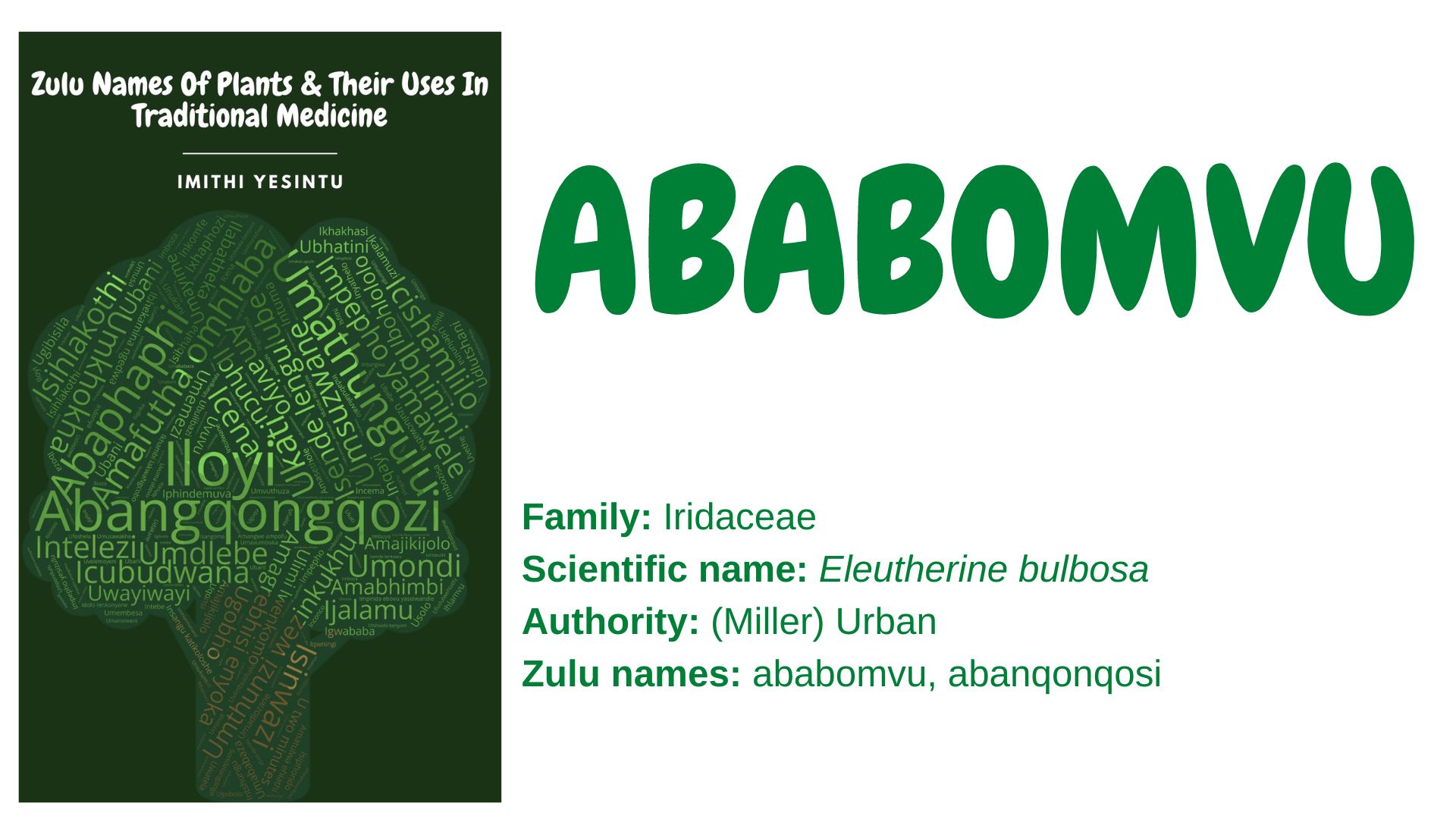Family: Iridaceae
Scientific name: Eleutherine bulbosa
Authority: (Miller) Urban
Synonyms: Antholyza meriana Blanco, nom. Illeg., Bermudiana bulbosa (Mill.) Molina, Cipura plicata (Sw.) Griseb., Eleutherine anomala Herb., Eleutherine longifolia Gagnep., Eleutherine plicata (Sw.) Herb., Ferraria parviflora Salisb., Galatea bulbosa (Mill.) Britton, Galatea plicata (Sw.) Baker, Ixia americana Aubl., Sisyrinchium bulbosum Mill., Sisyrinchium capitatum Pers., Sisyrinchium latifolium Sw.
Zulu names: ababomvu, abanqonqosi
Other names: tears of the virgin (English)
Plant description: E. bulbosa is a perennial herb with narrowly lanceolate leaves, small white evening-blooming flowers, and a red bulb that resembles red onion. It has been naturalised in various regions of Africa, including KwaZulu Natal, South Africa.
Uses:
- The plant has hallucinatory properties, hence it is used to make a psychoactive mixture used to induce lucid and vivid dreaming or visions.
- The bulb is used to treat dermatological problems. It contains anti-melanogenesis which is used to whiten the skin by inhibiting the production of the melanin pigment.
- The bulb is used in combination with Alpinia galanga to treat nasal congestion among children and to relieve colds. It is used to treat coughs, pertussis (whooping cough), and hemoptysis.
- The bulb is used to treat fertility problems, emmenagogue, menstrual pain, and for enhancing breast-milk production in women. It is also used as an abortive agent.
- The fresh bulb is chewed to treat jaundice and ulcers.
- The bulb is used to make an infusion that is used to relieve flatulence and regulate gastro-intestinal motility.
- The bulb is used to treat coronary disorders such as hypertension (high blood pressure).
- The bulb is used in diabetic treatment.
- The bulb is used in the treatment and management of stroke.
- The bulb is used for wound healing.
- The bulb is used as a purgative. It is used to treat diarrhoea and dysentery.
- The bulb is used in the treatment of breast cancer.
- The plant is used to make intelezi (a protective charm / mixture) that is sprinkled in and around the home.
- The plant is cultivated as a garden ornamental.
Safety precaution:
Using traditional medicine responsibly can enhance your overall health and well-being. Misuse and abuse can lead to complications. You can inquire about the correct use of traditional medicine from a knowledgeable herbalist and practitioner. You can also visit imithiyesintu.co.za or email: info@imithiyesintu.co.za to learn more about traditional medicine
References and further reading:
- Goldblatt, P. and Snow, N., 1991. Systematics and chromosome cytology of Eleutherine Herbert (Iridaceae). Annals of the Missouri Botanical Garden, pp.942-949.
- Hutchings, A., Scott, A.H., Lewis, G. and Cunningham, A.B., 1996. Zulu medicinal plants: an inventory. Pietermaritzburg: University of Natal Press.
- Ifesan, B.O.T., Joycharat, N. and Voravuthikunchai, S.P., 2009. The mode of antistaphylococcal action of Eleutherine americana. FEMS Immunology & Medical Microbiology, 57(2), pp.193-201.
- Kamarudin, A.A., Sayuti, N.H., Saad, N., Razak, N.A.A. and Esa, N.M., 2021. Eleutherine bulbosa (Mill.) Urb. Bulb: Review of the pharmacological activities and its prospects for application. International journal of molecular sciences, 22(13), pp.6747.
- Lans, C., 2007. Comparison of plants used for skin and stomach problems in Trinidad and Tobago with Asian ethnomedicine. Journal of Ethnobiology and Ethnomedicine, 3(1), pp.1-12.
- Leyama, T., Gunawan-Puteri, M.D. and Kawabata, J., 2011. α-Glucosidase inhibitors from the bulb of Eleutherine americana. Food chemistry, 128(2), pp.308-311.
- Lucena, G.M.D.S., Franco, J.L., Ribas, C.M., Azevedo, M.S., Meotti, F.C., Gadotti, V.M., Dafre, A.L., Santos, A.R. and Farina, M., 2007. Cipura paludosa extract prevents methyl mercury‐induced neurotoxicity in mice. Basic & clinical pharmacology & toxicology, 101(2), pp.127-131.
- Sobiecki, J.F., 2008. A review of plants used in divination in southern Africa and their psychoactive effects. Southern African Humanities, 20(2), pp.333-351.
- Tessele, P.B., Delle Monache, F., Quintão, N.L.M., da Silva, G.F., Rocha, L.W., Lucena, G.M., Ferreira, V.M., Prediger, R.D. and Cechinel Filho, V., 2011. A new naphthoquinone isolated from the bulbs of Cipura paludosa and pharmacological activity of two main constituents. Planta medica, 77(10), pp.1035-1043.
- Villegas, L.F., Fernández, I.D., Maldonado, H., Torres, R., Zavaleta, A., Vaisberg, A.J. and Hammond, G.B., 1997. Evaluation of the wound-healing activity of selected traditional medicinal plants from Peru. Journal of ethnopharmacology, 55(3), pp.193-200.
- Weniger, B., Haag-Berrurier, M. and Anton, R., 1982. Plants of Haiti used as antifertility agents. Journal of Ethnopharmacology, 6(1), pp.67-84.
- World Health Organization, 1990. Medicinal Plants in Viet Nam. WHO Regional Office for the Western Pacific.
- Zhengxiong, C., Huizhu, H., Chengrui, W., Yuhui, L.I., Jianmi, D., Sankawa, U., Noguchi, H. and Iitaka, Y., 1986. Hongconin, a new naphthalene derivative from Hong-Cong, the rhizome of Eleutherine ameicana Merr. et Heyne (Iridaceae). Chemical and pharmaceutical bulletin, 34(7), pp.2743-2746.
You Can Order Your Copy Of The Book By Emailing: info@imithiyesintu.co.za
Feel Free To Add Other Uses Of This Plant In The Comment Section Below:

